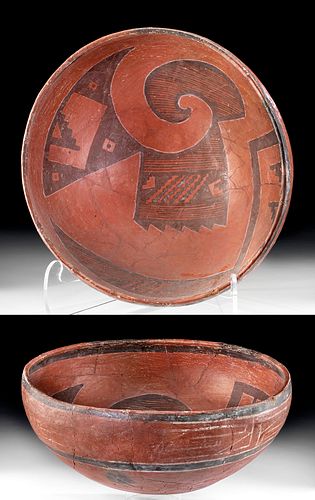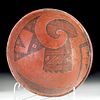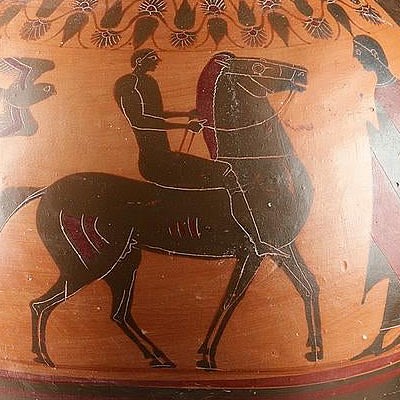Huge Pinedale Bichrome Pottery Bowl
Lot 153
About Seller
Artemis Gallery
686 S Taylor Ave, Ste 106
Louisville, CO 80027
United States
Selling antiquities, ancient and ethnographic art online since 1993, Artemis Gallery specializes in Classical Antiquities (Egyptian, Greek, Roman, Near Eastern), Asian, Pre-Columbian, African / Tribal / Oceanographic art. Our extensive inventory includes pottery, stone, metal, wood, glass and textil...Read more
Estimate:
$4,000 - $6,000
Absentee vs Live bid
Two ways to bid:
- Leave a max absentee bid and the platform will bid on your behalf up to your maximum bid during the live auction.
- Bid live during the auction and your bids will be submitted real-time to the auctioneer.
Bid Increments
| Price | Bid Increment |
|---|---|
| $0 | $25 |
| $300 | $50 |
| $1,000 | $100 |
| $2,000 | $250 |
| $5,000 | $500 |
| $10,000 | $1,000 |
| $20,000 | $2,500 |
| $50,000 | $5,000 |
| $100,000 | $10,000 |
| $200,000 | $20,000 |
About Auction
By Artemis Gallery
Jun 4, 2020
Set Reminder
2020-06-04 10:00:00
2020-06-04 10:00:00
America/New_York
Bidsquare
Bidsquare : Exceptional Antiquities, Asian, Ethnographic
https://www.bidsquare.com/auctions/artemis-gallery/exceptional-antiquities-asian-ethnographic-5185
An important one-day auction featuring museum-worthy examples of Egyptian, Greek, Roman, Etruscan, Near Eastern, Far East / Asian, Pre-Columbian, African / Tribal, Oceanic, Native American, Spanish Colonial, Russian, Fossils, Ancient Jewelry, Fine Art, so much more! Artemis Gallery info@artemisgallery.com
An important one-day auction featuring museum-worthy examples of Egyptian, Greek, Roman, Etruscan, Near Eastern, Far East / Asian, Pre-Columbian, African / Tribal, Oceanic, Native American, Spanish Colonial, Russian, Fossils, Ancient Jewelry, Fine Art, so much more! Artemis Gallery info@artemisgallery.com
- Lot Description
Southwestern USA, east central Arizona/west southern New Mexico, Ancestral Puebloan (Anasazi), ca. 1275 to 1325 CE. A large, fantastic bowl with bright colors that pop, created by artisans from the Mogollon Pinedale Polychrome tradition. The exterior features two thin black horizontal bands with white geometric motifs between them, while the interior has a complex black motif that resembles a bighorn sheep with its coiled horn visible on one side. Stepped, square, and fretted patterns create the rest of the highly abstract form, with much of the bowl's interior simply undecorated, earthy red. Bighorn sheep would have been abundant in the area where the woman who created this vessel lived and she may have been inspired by their form when she painted this. Size: 14.7" W x 6.5" H (37.3 cm x 16.5 cm)
The Mogollon people created pottery from iron-rich volcanic clays using the coil-and-scrape technique. The type is known primarily from the Pinedale Ruin, a settlement of approximately 200 rooms located near modern-day Show Low, Arizona, that was sadly lost to bulldozers in the 1970s. The people who lived at Pinedale would have been at the edges of the cultural sphere governed by Chaco Canyon, and by the time they created this bowl, lived a sedentary agricultural lifestyle. A bowl like this one may have held ground corn.
Provenance: ex-private C. Webster collection, Santa Fe, New Mexico USA acquired before 2000; ex-Jim Matthews collection
All items legal to buy/sell under U.S. Statute covering cultural patrimony Code 2600, CHAPTER 14, and are guaranteed to be as described or your money back.
A Certificate of Authenticity will accompany all winning bids.
We ship worldwide and handle all shipping in-house for your convenience.
#155974Expertly repaired and restored from multiple pieces with small areas of restoration/adhesive along the repair lines. This is well done and unobtrusive. Old collection number handwritten on underside. Nice preservation of painted motifs.Condition
- Shipping Info
-
All shipping is handled in-house for your convenience. Your invoice from Artemis Gallery will include shipping calculation instructions. If in doubt, please inquire BEFORE bidding for estimated shipping costs for individual items.
-
- Buyer's Premium



 EUR
EUR CAD
CAD AUD
AUD GBP
GBP MXN
MXN HKD
HKD CNY
CNY MYR
MYR SEK
SEK SGD
SGD CHF
CHF THB
THB

















